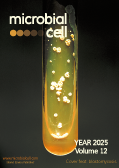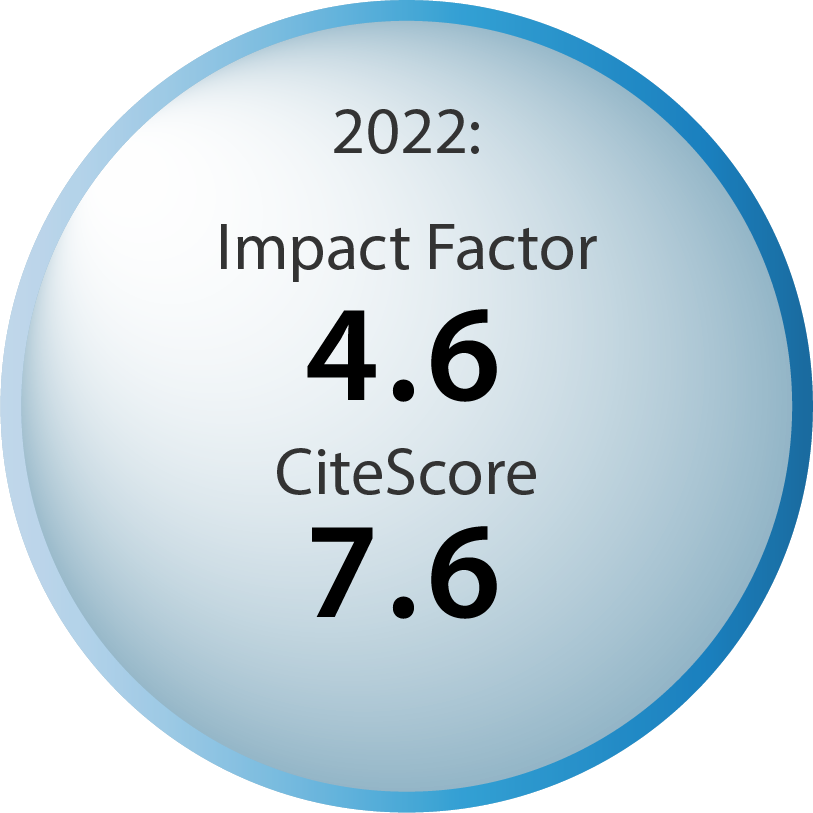Current Issue:
Table of contents
Volume 12, Issue 1, pp. 1 - , 1
Cover: Paracoccidioides brasiliensis is one of the causal agents of South American blastomycosis (paracoccidioidomycosis), a fungal infection that can affect different tissues. The cover image presents a slant culture test tube containing Sabouraud dextrose agar growth medium, which was inoculated with Paracoccidioides brasiliensis and then incubated an unidentified amount of time, at a temperature of 37°C (image by William Kaplan at the Centers for Disease Control and Prevention, USA; image modified by MIC). The cover is published under the Creative Commons Attribution (CC BY) license.
Enlarge issue cover
It takes four to tango: the cooperative adventure of scientific publishing
Didac Carmona-Gutierrez, Katharina Kainz and Frank Madeo
Editorial |
page 34-36 | 10.15698/mic2025.02.843 | Full text | PDF |
Abstract
The publication and scientific implementation of scholarly articles is a collaborative effort that unites readers, authors, editors, and referees. A scientific journal thereby serves as a vital platform, enabling these interactions and fostering a shared commitment to advancing the quality and impact of scientific communication. In this short editorial, we celebrate the milestone of publishing the 500th article in Microbial Cell by highlighting these collective efforts. Importantly, from the outset of the journal more than ten years ago, we have cultivated a handcrafted organ that is produced by scientists for scientists. In that frame, we have followed and advocated a radical open access approach that fuels interaction and visibility of such cooperative endeavors for the public good.
Paving the way for new antimicrobial peptides through molecular de-extinction
Karen O. Osiro, Abel Gil-Ley, Fabiano C. Fernandes, Kamila B. S. de Oliveira, Cesar de la Fuente-Nunez, Octavio L. Franco
In a nutshell |
page 1-8 | 10.15698/mic2025.02.841 | Full text | PDF |
Abstract
Molecular de-extinction has emerged as a novel strategy for studying biological molecules throughout evolutionary history. Among the myriad possibilities offered by ancient genomes and proteomes, antimicrobial peptides (AMPs) stand out as particularly promising alternatives to traditional antibiotics. Various strategies, including software tools and advanced deep learning models, have been used to mine these host defense peptides. For example, computational analysis of disulfide bond patterns has led to the identification of six previously uncharacterized β-defensins in extinct and critically endangered species. Additionally, artificial intelligence and machine learning have been utilized to uncover ancient antibiotics, revealing numerous candidates, including mammuthusin, and elephasin, which display inhibitory effects toward pathogens in vitro and in vivo. These innovations promise to discover novel antibiotics and deepen our insight into evolutionary processes.
Influence of cervicovaginal microbiota on Chlamydia trachomatis infection dynamics
Emily Hand, Indriati Hood-Pishchany, Toni Darville and Catherine M. O’Connell
Reviews |
page 93-108 | 10.15698/mic2025.04.848 | Full text | PDF |
Abstract
The cervicovaginal microbiome (CVM) is increasingly being considered as an important aspect of women’s health, particularly in relation to the risk and progression of sexually transmitted infections (STIs). CVM composition varies significantly between individuals and is shaped by factors including diet, age, environmental exposures, and lifestyle. Understanding these influences may shed light on how microbial imbalances contribute to infection susceptibility and the development of reproductive health disorders. Five distinct community state types (CSTs) classify common CVM compositions. Most CSTs (I, II, III, V) are characterized by a dominant Lactobacillus species and are associated with better or neutral reproductive health, including reduced coincident detection of STIs such as Chlamydia trachomatis. In contrast, CST IV is composed of diverse, predominantly anaerobic, microbial species and is associated with CVM dysbiosis, bacterial vaginosis, and a heightened risk of STI acquisition. This review examines the complex interplay between the CVM, C. trachomatis infection, and host immune responses, highlighting the role of metabolites such as short-chain and long-chain fatty acids, indole, and iron in modulating pathogen survival and host defenses. Additionally, the impacts of CVM composition on C. trachomatis persistence, ascension, and clearance are discussed, alongside co-infection dynamics with pathogens like Neisseria gonorrhoeae and Mycoplasma genitalium.
Unveiling the molecular architecture of the mitochondrial respiratory chain of Acanthamoeba castellanii
Christian Q. Scheckhuber, Sutherland K. Maciver and Alvaro de Obeso Fernandez del Valle
Reviews |
page 65-75 | 10.15698/mic2025.03.846 | Full text | PDF |
Abstract
Acanthamoeba castellanii is a ubiquitous free-living amoeba that can cause severe infections in humans. Unlike most other organisms, A. castellanii possesses a “complete” mitochondrial respiratory chain, meaning it contains several additional enzymes that contribute to its metabolic versatility and survival in diverse environments. This review provides a comprehensive overview of the mitochondrial respiratory chain in A. castellanii, focusing on the key alternative components involved in oxidative phosphorylation and their roles in energy metabolism, stress response, and adaptation to various conditions. The functional characterization of the alternative oxidase (AOX), uncoupling protein (UCP), and alternative NAD(P)H dehydrogenases, highlight their roles in reducing oxidative stress, modulating proton gradients, and adapting to changes in temperature and nutrient availability. These proteins and systems serve a role in the survival of A. castellanii under stressful conditions such as starvation and cold conditions. Further knowledge of the respiratory chain of the amoeba has potential implications for understanding the evolution of mitochondrial respiration and developing new therapies for treating Acanthamoeba infections.
Clostridium scindens promotes gallstone formation by inducing intrahepatic neutrophil extracellular traps through CXCL1 produced by colonic epithelial cells
Wenchao Yao, Yuanhang He, Zhihong Xie, Qiang Wang, Yang Chen, Jingjing Yu, Xuxu Liu, Dongbo Xue , Liyi Wang and Chenjun Hao
Research Articles |
page 37-52 | 10.15698/mic2025.03.844 | Full text | PDF |
Abstract
Cholelithiasis is one of the most common diseases of the biliary system. Neutrophil extracellular traps (NETs) in the liver play an important role in accelerating the formation of gallstones. The upstream mechanism of NETs formation remains unclear. In this study, 16S rRNA sequencing was used to screen the differential gut microbiota in mice with gallstones. Transcriptome sequencing was used to screen the differentially expressed core genes and signalling pathways of Clostridium scindens that acted on human colonic epithelial cells. Western blotting was used to verify the protein expression of TLR2 and the NF-κB pathway. RT-PCR was used to verify the mRNA expression of TLR2, CXCL1 and the NF-κB pathway. ELISA was used to verify CXCL1 expression in the supernatant or portal vein blood of mice. Immunofluorescence was used to detect NETs formation in cocultured neutrophils in vitro or in mouse livers. Clostridium scindens was the key differential strain in the formation of gallstones in mice. After treatment with Clostridium scindens, both in vitro and in vivo, the expression of TLR2 was upregulated, the secretion of CXCL1 was increased by regulating the NF-κB pathway. Finally, the formation of NETs and stones was significantly increased. This study reveals a new mechanism of the gut-liver immune axis in the formation of gallstones. Clostridium scindens acts on colonic epithelial cells through TLR2 to regulate the NF-κB pathway and increase the secretion of CXCL1. CXCL1 enters the liver via the portal vein and increases the formation of NETs in the liver, thereby accelerating gallstone formation.
Ampicillin treatment in persister cell studies may cause non-physiological artifacts
Michel Fasnacht, Hena Comic, Isabella Moll
Research Articles |
page 53-64 | 10.15698/mic2025.03.845 | Full text | PDF |
Abstract
Persister cells are a clinically relevant sub-population of an isogenic bacterial culture that is tolerant to bactericidal antibiotics. With the aim to investigate the ribosomal protein content of persister cells, we employed the bacteriolytic properties of ampicillin to separate persister from sensitive cells. Thereby, we observed processing of several ribosomal proteins. Promisingly, we detected a variant of the large subunit protein uL2 that lacks the last 59 amino acids from its C-terminus (tL2) and which previously has been described as an inhibitor of DNA replication in vitro. Considering the increasing number of moonlighting functions described for ribosomal proteins, we investigated a potential regulatory role of tL2 in persister cells after ampicillin treatment. In contrast to our assumption, our findings show that the generation of tL2 after ampicillin treatment must be attributed to proteolysis upon cell lysis. Ultimately, no tL2 was detected intracellularly of purified persister cells isolated by an improved protocol employing proteinase K treatment. We therefore exclude the possibility of tL2 regulating DNA replication in ampicillin tolerant E. coli cells. Nevertheless, this study clearly highlights the necessity of further purification steps in addition to ampicillin treatment for the study of persister cells and invites for the careful re-examination of previously published results.
Integrative Omics reveals changes in the cellular landscape of peroxisome-deficient pex3 yeast cells
Tjasa Kosir, Hirak Das, Marc Pilegaard Pedersen, Ann-Kathrin Richard, Marco Anteghini, Vitor Martins dos Santos, Silke Oeljeklaus, Ida J. van der Klei and Bettina Warscheid
Research Articles |
page 9-33 | 10.15698/mic2025.02.842 | Full text | PDF |
Abstract
Peroxisomes are organelles that are crucial for cellular metabolism, but they also play important roles in non-metabolic processes such as signalling, stress response or antiviral defense. To uncover the consequences of peroxisome deficiency, we compared Saccharomyces cerevisiae wild-type with pex3 cells, which lack peroxisomes, employing quantitative proteomics and transcriptomics technologies. Cells were grown on acetate, a carbon source that requires peroxisomal enzymes of the glyoxylate cycle to generate energy and essential carbohydrates, and that does not repress the expression of peroxisomal genes. Our integrative omics analysis reveals that the absence of peroxisomes induces distinct responses at the level of the transcriptome and proteome. Transcripts of genes and corresponding proteins that are associated with peroxisomal β-oxidation were mostly increased in pex3 cells. In contrast, levels of peroxins were regulated at protein but not at transcript level. Membrane-bound peroxins were reduced, whereas the soluble receptors Pex5 and Pex7 were increased in abundance in pex3 cells. Interestingly, we found several non-peroxisomal transcript and proteins regulated in pex3 cells including mitochondrial proteins involved in respiration or import processes, which led to the identification of the mitochondrial pyruvate carrier Mpc1/3 as so far unnoticed transporter present in the peroxisomal membrane. Our results reveal the impact of the absence of peroxisomes in pex3 yeast cells and represent a rich resource of genes/proteins for follow-up studies to obtain a deeper understanding of peroxisome biology in a cellular context.
Microbiota and metabolome dynamics induced by Shiga toxin-producing E. coli in an in vitro model of an infant’s colon
Mariana Izquierdo, Deborah O’Sullivan, Ophélie Uriot, Morgane Brun, Claude Durif, Sylvain Denis, Pablo Gal-lardo, Cormac G M Gahan, Lucie Etienne-Mesmin, Stéphanie Blanquet-Diot and Mauricio J. Farfan
Research Articles |
page 76-92 | 10.15698/mic2025.04.847 | Full text | PDF |
Abstract
Shiga toxin-producing Escherichia coli (STEC) is a major food-borne pathogen causing human diseases ranging from diarrhea to life-threatening complications, mainly in young children. Colonization, virulence, and interactions of STEC strains with human gut microbiota are pivotal during infection but remain poorly described, particularly in children, the most affected population. In this work, we evaluated changes in the microbiota and metabolome composition in the in vitro gut model: Toddler ARtificial COLon (T-ARCOL) infected with EHEC O157:H7 strain EDL 933. Stool samples collected from children with STEC-positive diarrhea and stool from the same children after recovery from the diarrheal episode (n=5) were used to inoculate the T-ARCOL model. STEC colonization was progressively reduced throughout fermentation in T-ARCOL with diarrhea or recovery fecal samples. Beta diversity showed that the diarrhea-associated microbiota was significantly distinct from the recovery microbiota and exhibited a lower α-diversity. In contrast to recovery conditions, diarrheal conditions were characterized by an increased abundance of potential pathobionts such as members of the Clostridiaceae family and higher acetate, succinate, and N-acetylneuraminic acid levels. Our results provide new evidence of the impact of EHEC in the microbiota and metabolome dynamics in an in vitro gut model that could be useful in understanding their physiopathology in this at-risk population, considering inter-individual variabilities in gut microbiota.










